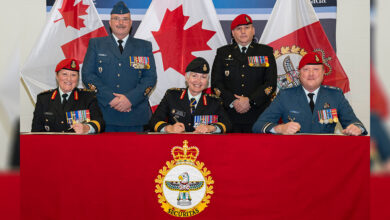Policy
Minister Announces Canada Set to Procure 12 Submarines
Above image: HMCS WINDSOR, a VICTORIA Class submarine exchanges passengers with HMCS FREDERICTON using a Zodiac during Canadian Fleet Operations. HMCS FREDERICTON is participating in the exercise along with other Canadian and American naval vessel.
Canada has its eyes set on procuring 12 “conventionally-powered, under-ice capable submarines” to bolster its presence and strength in Canada’s Arctic.
According to the announcement made by Minister Bill Blair on Wednesday, the need to bolster Canada’s submarine capabilities stems from several factors, including more Russian activity and the area’s general increasing accessibility.
“As the country with the longest coastline in the world, Canada needs a new fleet of submarines – and today, we’ve announced that we will move forward with this acquisition. This new fleet will enable Canada to protect its sovereignty in a changing world, and make valuable, high-end contributions to the security of our partners and NATO Allies. We look forward to delivering this new fleet to the Royal Canadian Navy,” said Blair, Minister of National Defence.
Through this modernization, the government hopes to retire its increasingly obsolete Victoria-class submarines.

Taking first steps
Under the umbrella of the Canadian Patrol Submarine Project (CPSP), Canada will take the first steps to modernize the Royal Canadian Navy’s submarines.
According to the military, Canada’s current Victoria-class submarines were purchased from the British government in 1998. The four submarines were sent and commissioned to the RCN from 2000 to 2004.
The government has committed to modernizing this fleet into the mid-2030s. According to a press release from the Department of National Defence (DND), the department is currently meeting with manufacturers and potential partners to deliver on this modernization.
The government is looking for submarines that will allow the RCN to be stealthy, lethal, and deployable in the Arctic.
“Canada’s new fleet will need to provide a unique combination of these requirements to ensure that Canada can detect, track, deter and, if necessary, defeat adversaries in all three of Canada’s oceans while contributing meaningfully alongside allies and enabling the Government of Canada to deploy this fleet abroad in support of our partners and allies,” stated a DND press release.

Increasing Threats
As the country with the largest coastline in the world, Canada is also more susceptible to foreign threats in its water. No greater is this threat than in the Arctic. According to the Canadian military, the Arctic region is becoming more accessible to foreign invaders, with both Russia and China setting their sites in the area.
According to the military, competitors are looking to the region for access to transportation routes, natural resources, critical minerals, and energy sources.

Investing in the new defence policy
Investing in a new submarine fleet is not the only investment the government seeks to make under its Our North, Strong and Free defence policy. Over the next five years, the government intends to pour $8.1 in defence spending, totalling $73 billion in the next twenty years.
New equipment the government hopes to acquire under this policy include:
- new vehicles adapted to winter weather,
- acquire ground-based air defences,
- acquiring long-range air and sea-launched missiles,
- modernizing artillery capabilities and much more.









